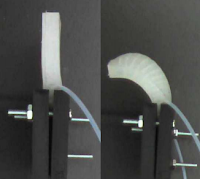My black Friday Pololu order arrived this morning. I'm delighted with the purchase, and one item in particular has blown me away. It's a MiniMU-9 , which combines a triple-axis gyro, a triple-axis accelerometer and a triple-axis magnetometer. In other words, it measures all the data you need to work out the position and orientation of a mobile robot. And it's tiny. To give you a feeling of its size, the connector holes in the image are 0.1" apart, and it weighs just under a gram. Now if only I had a small, low-cost lightweight, Linux-capable board to control it, I could build an autonomous blimp. But that's just Pi in the Sky :) Seriously, the Raspberry Pi (described in the Register article linked to above) is well-suited to the job of managing an autonomous blimp. It's true that the gumstix is even smaller than the Pi, and available this month rather than next; but it costs a lot more. Meanwhile I have projects stacked up that will keep me occu...






























